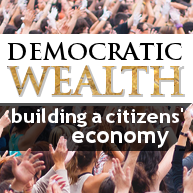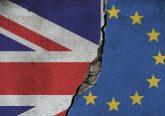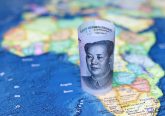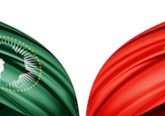 Basic income is a regular unconditional cash grant paid to all citizens without any means test or work requirement. It’s often dismissed as a utopian idea.
Basic income is a regular unconditional cash grant paid to all citizens without any means test or work requirement. It’s often dismissed as a utopian idea.
However, a basic income, or something very close to it, exists today in Alaska. It’s called the Permanent Fund Dividend (PFD) or sometimes “the Alaska Dividend.”
The PFD has been paying annual dividends to Alaskans since 1982 with no conditions except citizenship, residency, and the willingness to fill out a form. After following the Alaska Dividend since 1999, I want to share six lessons that supporters of progressive economic policy should learn from what I call “the Alaska model,” but first some basic background.
In 1956, Alaska ratified a constitution recognizing joint ownership of unoccupied land and natural resources. In 1967, North America’s largest oil reserve was discovered in state owned areas on Alaska’s North Slope. In 1976, a state referendum created the Alaska Permanent Fund (APF), a portfolio of diversified assets, into which the government would invest a small part of the state’s oil revenue each year as a way to turn the temporary stream of oil money into permanent wealth. Back then, the state had no plan for what to do with the APF. In 1982, the state government finally decided to distribute part of the returns from that fund as a yearly dividend, and the Alaska model was born. The APF continues to rise with yearly deposits from oil revenue, and it goes up and down with the financial markets.
The PFD is derived from the returns of the APF’s investments. With some effort to smooth out the ups and downs, the dividend fluctuates with the markets. In 2008, the dividend (plus a onetime supplement of $1,200) reached a high of $3,269, which comes to $16,345 for a family of five. After the financial meltdown of 2008, the dividend has declined, reaching $878 per year in 2012. That’s still $4,390 for a family of five. Now that world markets have come back, the APF recently reach a new high of $46 billion. Higher dividends are likely to follow in a few years.
The APF and PFD are not perfectly designed, but they are an important and innovative example of democratic wealth existing in the world today. The APF is community-owned wealth invested in the private economy. The PFD converts some of the returns to that wealth into democratically distributed income. Together, the Alaska model is something, from which we can learn, and on which we can improve. An unconditional cash dividend of $4,000 to $16,000 per year for a family of five is significant for everyone except for the wealthiest people, and it is extremely significant for people living at the margins. It has helped Alaska maintain one of the lowest poverty rates in the United States. It has helped Alaska become one of the most economically equal of all 50 states. And during the 1990s and 2000s it helped Alaska become the only US state in which equality rose rather than fell (for more on this, see this book on the Alaska model I co-edited with Michael W. Howard). Alaska is doing something right, and the dividend is a part of it. Here are the six lessons from the Alaska model.
1. Resource dividends work and they’re popular
At a time when conditional social policies are under attack across the industrialized world, the Alaska Dividend continues to be extremely popular. It is sometimes called “the third rail of Alaska politics,” implying any politician who touches it dies. In 1999, a ballot initiative proposed diverting funds from the APF was rejected by more than 80 percent of Alaska voters. Think about that. It’s hard to get 80 percent of people to vote the same way on anything. But here we have 80 percent of Alaskans voting for a policy that fights poverty and promotes equality.
2. You don’t have to be resource rich to have a resource dividend.
It’s easy dismiss anything connected with Alaskan oil is an aberration, something possible only because of Alaska’s enormous windfall. But there are three reasons why nearly any political community can do what Alaska has done:
First, Alaska isn’t unusually rich. Oil transformed it from one of the poorer to one of the wealthier U.S. states, but Alaska is only the tenth richest of the states with a per capita GDP of about $42,000—only $2,500 higher than the national average. Alaska has no greater financial means than many other states and nations.
Second, the entire dividend is financed by only a small fraction of Alaska’s resource wealth. The APF is supported almost exclusively by taxes on a single resource, oil. Alaska’s taxes on oil are very low by international standards. And the state devotes only a small portion of that revenue to the APF. If Alaska devoted, say half of its potential resource revenue to the APF, the PFD could easily be five to ten times what it is now.
Third, every country, state, and region has resources—extremely valuable resources—but we don’t think of them the way we do of gas and oil because we’re so used to governments giving them away to corporations who sell them back at a profit and pay very little in taxes. Recent estimates by Gary Flomenhoft show that a resource-poor state, Vermont, could support a dividend two- to five-times larger than the PFD, if it made judicious use of resource taxes. The most resource-poor countries in the world are probably Hong Kong and Singapore, where millions of people are crowded together on a little island, and they have to import almost all their consumption goods. But these countries have fabulously valuable real estate. I wouldn’t be surprised if a tax on Singapore’s land could support something much larger than the Alaska Dividend. For the most part, the difference between being “resource rich” and “resource poor” is the difference between having the kind of resources states usually tax and the kind they usually give away for free.
3. Look for opportunities
Alaskans don’t have the dividend because they are resource-rich. They have it because some smart Alaskans took advantage of the opportunity. Common resources are being privatized all the time all over the planet. We could tax privatized resources, but the easiest place to start is at the moment of privatization. Every new well that’s drilled is an opportunity to assert community control of resources. So is every new mine that’s dug, every new reserve that’s discovered, every new smokestack that seeks to use the atmosphere as a garbage dump.
Less obvious opportunities are just as real. The US government recently gave away a huge portion of the broadcast spectrum to private companies for digital television broadcasting. If they had auctioned off leases to the highest bidder, they would have created a stream of income worth billions of dollars every year as long as broadcast exists. That was an enormous lost opportunity. Today, increased awareness about the need to do something about global warming is another opportunity. Two strategies currently being discussed, “tax and dividend” and “cap and dividend,” would make polluters pay for the damage they do to the environment and return the proceeds to everyone as a dividend. Opportunities are all around, if we look for them.
4. Think like an owner. Think like a monopolist. Think like Johnny Carson
There is a danger in the Alaska model. If everybody gets paid when we privatize resources, they might want to privatize more resources and allow more damage to the environment. The solution to this problem is that once the community demands fees for the use of its resources, it asserts ownership of those resources. Once members of the community begin to think of themselves as the owners of their environment, new opportunities open up. The community is the owner; government is the broker; business is the hired help. The owner sets the terms of rental. They can allow private exploitation of their property only with strong environmental protections attached. The right to compensation is only one of the rights of ownership—along with it comes the right to manage, regulate, and restrict access. Receiving payment for resources helps the members of the community think of themselves as joint owners of the environment with the power to insist that tenants be good stewards of the environment.
Once members of the community start to think of themselves as owners of the community’s resources, they need to realize that, as a group, they have a monopoly over those resources. Monopolists don’t sell all they can at bargain prices. They restrict supply, selling less to get higher prices. Once we think about maximizing profit from resources, big corporations can forget about bargain deals.
But we should not think like just any monopolist. We should think like Johnny Carson. Who? In the 1970s, Johnny Carson hosted the most popular talk show on American television. Because he could have gone to any network and brought his audience with him, he demanded and got a salary that made him the highest paid entertainer in the world, but he didn’t stop there. He gradually demanded more vacation time, eventually getting something like four months per year. Then, he decided to reduce his weekly workload by one day. So he worked four days a week, eight months a year, and he was still the highest paid entertainer in the world. Johnny Carson realized that his time was valuable not only when sold, but also when unsold. As monopoly owners of the commons who think of our environment the way Johnny Carson thought of his time, we could have more money coming in while we also secure larger parks, more nature reserves, less pollution, and better resource management.
5. Build a constituency
The feeling of shared ownership is one of the reasons resource dividends tend to be so popular once they’re in place. They build a large constituency who will defend the policy when attacked. Talking to Alaskans reveals a greater sense of ownership of Alaska’s oil reserves than of other state property and a greater sense of ownership of the APF than of the state’s oil reserves.
Another way way to build a constituency is through universal rather than targeted policies. It is easy for politicians to single out the recipients of targeted programs, because they are a relatively small and marginalized group, but a dividend, large enough to make a difference for the majority of the population, is much safer from attack.
A third way to build a constituency is to make policy significant. Insignificant gimmicky programs might be easier to pass, but they are also easier to cut when a less favorable administration comes into power. If a politician proposed cutting the Alaska Dividend, all Alaskans would face losing $1,000–$2,000 a year for the rest of their lives. Whether that politician was promising a tax cut or some other spending program, they would put a universal constituency of Alaskans in the position where they would sacrifice something very significant for the uncertainty that the replacement will be delivered. Alaskans care about the PFD because it makes a difference in their lives.
6. Avoid creating an opposition
Just as some policies create larger constituencies than others, some create greater opposition than others. Policies, such as the minimum wage and rent control, put most of their burden on one, specific, easily identifiable group who will probably fight the program as long as it exists. Even if financed by broad-based income tax, targeted redistribution can create an opposition if a significant number of taxpayers see it as something they’re unlikely to need.
The APF and PFD have virtually no opposition. No one has reason to feel burdened by their creation and continued existence. It’s just a pile of money that the state happens to own. No one feels infringed by it. Of course, the APF is created and continually enlarged by taxes on the oil industry, and they do try to lower their tax burden as much as they can. But they have much harder time making complaint to the public. Opposing oil royalties is like complaining that they have to pay a price for steel, trucks, or ships. It doesn’t make sense to complain about what is obviously an unavoidable cost of doing business. That’s just the way of the world. In Alaska, Norway, and some other places, the state owns the oil fields. Anyone who wants to drill must pay. And nowthat’s the way of the world. A good solid policy can change the way the world works.
This piece draws heavily on the lessons discussed in Alaska’s Permanent Fund Dividend: Examining its Suitability as a Model and Exporting the Alaska Model: Adapting the Permanent Fund Dividend for Reform around the World, both of which are coedited by Michael Howard.
This piece is part of the Democratic Wealth series, hosted by OurKingdom in partnership with Politics in Spires.








2 Comments